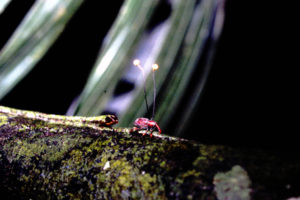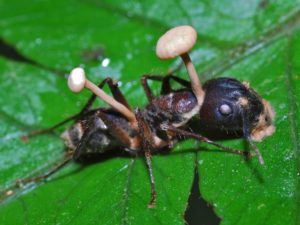 Walking within the tropical rainforest of the Peruvian Amazon is always an adventure. One never quite knows what to expect next. It could be a hitherto un-encountered monkey species, an important medicinal plant, a spectacularly colored bird, or a Yagua hunter moving stealthily along the path blowpipe in hand. On this occasion, the encounter involved an insect and it opened a window into an often hidden aspect of tropical rainforest biology both fascinating and disturbing.
Walking within the tropical rainforest of the Peruvian Amazon is always an adventure. One never quite knows what to expect next. It could be a hitherto un-encountered monkey species, an important medicinal plant, a spectacularly colored bird, or a Yagua hunter moving stealthily along the path blowpipe in hand. On this occasion, the encounter involved an insect and it opened a window into an often hidden aspect of tropical rainforest biology both fascinating and disturbing.
As I slowly and quietly stepped along the trail, with my companion and guide Pablo, I scanned the surrounding forest floor and middle stories of the trees. We had already had good luck that morning with excellent views of saddle-backed tamarins and squirrel monkeys. I had also gotten my first look at one of my favorite Amazonian  birds, a stunning little wire-tailed manakin – a gem of the rainforest not to mention one of its most accomplished dancers. As we continued along the trail, my eyes wandered over the surrounding vegetation. On the lookout for any movement, I also scanned for the quiet presence of eyelash viper, a species prone to lie about on low vegetation.
birds, a stunning little wire-tailed manakin – a gem of the rainforest not to mention one of its most accomplished dancers. As we continued along the trail, my eyes wandered over the surrounding vegetation. On the lookout for any movement, I also scanned for the quiet presence of eyelash viper, a species prone to lie about on low vegetation.  This habit made it a good idea to always look ahead and be aware of where one placed arms, legs, and torso. As I glanced to my left, I noticed a liana creeping from the ground and ascending at a shallow angle up into a nearby tree. Perched upon this liana was a small insect. But what a strange little insect it was. Protruding from its body was what I took to be a pair of exceedingly long antennae. But something didn’t seem quite right; the antennae seemed greatly out of proportion to the insect’s size. Stepping closer, I recognized the insect as a snout beetle. Curculionids are
This habit made it a good idea to always look ahead and be aware of where one placed arms, legs, and torso. As I glanced to my left, I noticed a liana creeping from the ground and ascending at a shallow angle up into a nearby tree. Perched upon this liana was a small insect. But what a strange little insect it was. Protruding from its body was what I took to be a pair of exceedingly long antennae. But something didn’t seem quite right; the antennae seemed greatly out of proportion to the insect’s size. Stepping closer, I recognized the insect as a snout beetle. Curculionids are

so-called because the front of their head is elongated and forms what appears to be an extended proboscis. Surprisingly, the structures that I had mistaken for antennae were not that at all. First, they were not growing from the head where they should have been. I now saw that they were actually two long filaments extending upwards from the joint between the head and the thorax of the beetle. And, the end of each filament bore an oval, thin-walled sac. These were not antennae. They were the spore producing organs of a fungus! So, here it was at last. I had finally encountered the legendary Cordyceps fungus, the stuff of science fiction nightmare.
Some days previously such a fungus had released its spores into the air. One of these spores, wafted upon the minuscule breezes which circulate near the forest floor, had landed upon the unsuspecting snout beetle whose corpse now rested before me. From the spore, minute threadlike filaments which form the vegetative body of a fungus had begun to grow. Aided by their enzyme secretions, these mycelia penetrated the beetle’s first line of defense, its chitinous exoskeleton. Now they began to grow into the insect’s body. But here is where the intriguing part of the Cordyceps story really begins.
One would think that, having gained access to the soft tissues, the fungus would begin to randomly eat away at this nutrient rich flesh. But this is not so. Guided by some elaborate but mysterious biochemical “instinct”, the fungus had begun to feed on its unsuspecting host in a highly selective manner. While using the beetle as a food source, the fungus had diligently avoided feasting on any of the insect’s vital organs. Damage to any organs which might quickly kill its host was studiously avoided by the Cordyceps. Slowly, over a period of days, the fungus digested the non-vital tissues of its host insect. Having eaten its fill so to speak, the fungus now began to exert what is inarguably its most astounding influence on the hapless victim. Through the use of incompletely understood biochemical mechanisms, the fungus initiated a sudden change in the behavior of its insect host.
The snout beetle was seized by an irresistible urge to leave its home on the forest floor and to climb. Ascending onto the liana the beetle, most remarkably, scaled to a specific height above the ground. Here at its final position the altitude, humidity, and exposure to gentle breezes were precisely correct for the Cordyceps to have its reproductive cells dispersed. Having reached this optimal perch, the fungus proceeded to complete its digestion of the insect’s internal organs and to grow its spore producing organs.
In some cases, fungi of this type cause even more bizarrely specific  behaviors. Ants infected in such a way may not just climb to a precise height about the ground. They are also induced by the fungal parasite to clamp their jaws onto a stem or leaf petiole with great force. Thus fastened to its perch the ant, after its death, is less likely to fall back to the forest floor before the fungi’s spores are released into the air. Based upon fossil evidence, it appears that this fungus-insect relationship may have evolved several tens of millions of years ago. As this scenario played through my mind, I reflected back to a comment I once heard made by a tropical rainforest biologist. Referring to this type of fungi’s devious biochemical mind control of the host he said, “. . . and we refer to the fungi as a lower form of life?”
behaviors. Ants infected in such a way may not just climb to a precise height about the ground. They are also induced by the fungal parasite to clamp their jaws onto a stem or leaf petiole with great force. Thus fastened to its perch the ant, after its death, is less likely to fall back to the forest floor before the fungi’s spores are released into the air. Based upon fossil evidence, it appears that this fungus-insect relationship may have evolved several tens of millions of years ago. As this scenario played through my mind, I reflected back to a comment I once heard made by a tropical rainforest biologist. Referring to this type of fungi’s devious biochemical mind control of the host he said, “. . . and we refer to the fungi as a lower form of life?”
 Although they now reside within their own taxonomic kingdom, several generations of biologists once thought of fungi as odd members of the plant kingdom. Fungi lack the indicators of complexity we humans hold in high esteem such as mobility, a central nervous system, and some degree of intelligence. In light of this, the ability of an organism such as Cordyceps to invade an animal and take over control of its mental faculties is downright astounding – and scary. Lest you think that Cordyceps is unique in its uncanny ability to turn its host into a virtual zombie, stay tuned. The Stealth Attack Part 2 will be coming soon.
Although they now reside within their own taxonomic kingdom, several generations of biologists once thought of fungi as odd members of the plant kingdom. Fungi lack the indicators of complexity we humans hold in high esteem such as mobility, a central nervous system, and some degree of intelligence. In light of this, the ability of an organism such as Cordyceps to invade an animal and take over control of its mental faculties is downright astounding – and scary. Lest you think that Cordyceps is unique in its uncanny ability to turn its host into a virtual zombie, stay tuned. The Stealth Attack Part 2 will be coming soon.
Photo Credits: saddle-backed tamarin courtesy of the Univ. of Windsor Bio. Dept. wire-tailed manakin by Juniorgirotto at Wikimedia Commons eyelash viper at Wikimedia Commons fungus-infected ant by Bernard DuPont at Wikimedia Commons fungi cluster courtesy of sceincing.com fungus-infected beetle by the author
